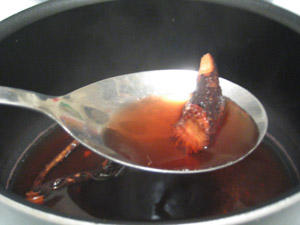Purple Green Beans and More Risotto

Believe it or not, these purple beans turn green almost the instant they hit boiling water. They are delicious, though, and if they're blanched in boiling, salted water for about a minute and a half, and then refreshed in ice water, they make a lovely addition to a chicken salad that features crisp vegetables, tangy vinaigrette, and fresh mozzarella.
I've said before that good tomatoes are hard to find. But sometimes all you need is a little extra cheese and Prego! It's in there! Flavor, texture, salt, it's all there. Tonight's adventure in risotto involved some weak Roma tomatoes, an accidental cheese spill, and some reassurance from a fellow cheese lover that it would be fine. And it was. Too much cheese? Impossible!
Risotto al Pomodoro (e Formaggio)
Following roughly along with the basic risotto from earlier this week, you can add a few peeled tomatoes just after the onions are soft, and cook them until they become saucy. Add the rice and allow it to absorb the tomato sauce. Add about 6 cups of unsalted chicken broth, as before, ladle by ladle (test the rice occasionally for doneness). When the rice is just tender, finish with butter and olive oil, add a cup of diced fresh mozzarella, a dozen shredded basil leaves, and a half cup of grated parmesan. Salt and pepper to taste, and serve immediately. This dish has the freshness of a margherita pizza with a creaminess that could only come from risotto.
To peel tomatoes, dunk a couple at a time into boiling water for 10-20 seconds. Cut the stem out and peel from the stem end with a knife. Return to boiling water briefly if the skin is being difficult.
Below is a cool, tangy dessert that could go well with your next summertime meal. I had a heck of a time freezing the granita, but it had a clean taste that finished the meal off nicely.
Granita di Pompelmo con Panna
1/3 c water
1/2 c sugar
2 1/2 c fresh grapefruit juice
2 star anise (optional)
1/2 pint whipping cream
1 T powdered sugar
Heat sugar and water in a small saucepan until the sugar has dissolved. Combine with grapefruit juice and pour into a shallow metal pan. Place the pan in a freezer and stir up the ice crystals every 40 minutes or so until completely frozen. Alternatively you can let the juice freeze solid and shave the ice with a spoon.
Beat the whipping cream until it forms soft peaks. Mix in the sugar. Layer glass dishes with whipped cream and granita. You can keep it in the freezer until serving time, though your whipped cream may be more like ice cream. It's a tricky balance because the acid from the juice could turn your whipped cream into cheese if everything's not frozen. Makes 6-8 servings.
Optionally, you could take a batch or two of home brew espresso, sweeten to taste, and freeze as above for a traditional granita di caffe, and it's even better with the layered cream.







